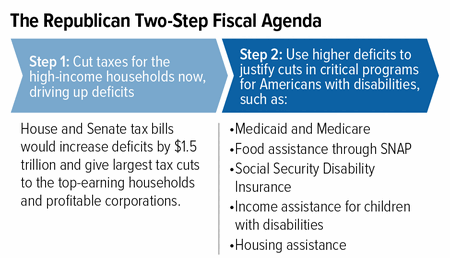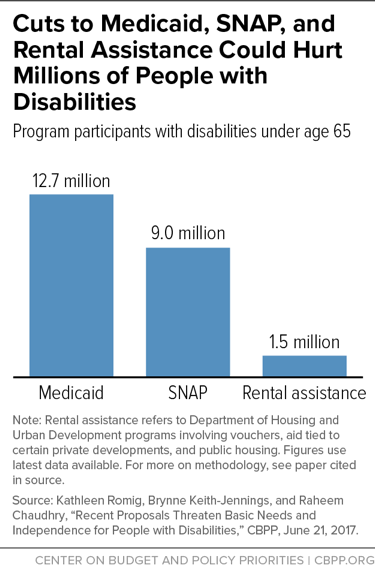- Home
- Federal Budget
- Republican Plans To Cut Taxes Now, Cut P...
Republican Plans to Cut Taxes Now, Cut Programs Later Would Hurt People with Disabilities
Congressional Republicans this fall are poised to launch step one of a likely two-step tax and budget agenda: enacting costly tax cuts now that are heavily skewed toward wealthy households and profitable corporations, then paying for them later through program cuts mostly affecting low- and middle-income families. People with disabilities would lose more from the program cuts than they would gain from the tax cuts.
Congress appears headed toward crafting a tax-cut bill that would largely benefit the top 1 percent of households and profitable corporations, while increasing deficits by $1.5 trillion over the next decade. (And the true cost, with no budget gimmicks, could be even higher.) Tax cuts will lead to larger deficits — claims that tax cuts pay for themselves fly in the face of decades of experience and credible, mainstream economic research.
When deficits rise, those who supported the tax cuts will likely label these deficits as unacceptable and point to spending as the culprit. When that happens, they presumably will call for the kinds of deep cuts they’ve already proposed in their long-range budget plans, which would hit key health care, nutrition, and income assistance programs that many people with disabilities count on. Those cuts could happen as soon as next year.
Congressional Republicans could have chosen to write a single bill with both the tax cuts they favor and the program cuts or tax increases to pay for them. This would have enabled the public and policymakers to evaluate the tradeoffs and make an informed decision. Instead, they have chosen to obscure this tradeoff by splitting their agenda into two parts. But this doesn’t change the reality: the wealthy would win large tax cuts while everyone else would pay the tab.
When Tax Cuts Must Be Paid For, People With Disabilities Likely to Bear Significant Burden
President Trump and congressional leaders have been very clear on the areas they want to cut. The Trump and congressional budget plans for the next decade would cut income assistance and health care for millions of low- and moderate-income people with disabilities, including children — making it harder for them to afford the basics and access needed health care. Indeed, the Administration and congressional leaders have pointed to existing projected deficits — even before $1.5 trillion in deficit-increasing tax cuts are made -— to justify these cuts.
For example, materials accompanying an earlier budget plan put forward in the House claimed that spending rates for programs like Medicare, Medicaid, and Social Security “are unsustainable and the key drivers of our nation’s fiscal challenge,” even as the GOP tax plans call for large tax cuts for the wealthy and profitable corporations. Once a tax bill becomes law and deficits grow, many of the same policymakers who supported the tax cuts will likely argue that the resulting higher deficits make cutting programs supporting people with disabilities even more urgent.
-
Medicaid. The Trump and congressional budget plans call for cutting Medicaid and subsidies to purchase coverage through the Affordable Care Act marketplaces by between $1.3 trillion and $1.9 trillion over the next decade, with most of the cuts coming from Medicaid. The cuts would grow over time. For example, under the Trump plan Medicaid alone would be cut by 47 percent in 2027. Nearly 13 million non-elderly Americans with disabilities, including 2 million children, receive health coverage through Medicaid. States facing steep funding cuts would be forced to limit eligibility and scale back services, including for people with disabilities. These cuts could make it harder for many people with disabilities to qualify for Medicaid, threaten the home- and community-based services that enable them to stay out of institutions, and cut school funding for children with disabilities.
-
Disability Insurance. The Trump budget would cut tens of billions from Social Security Disability Insurance. Among other things, it would cut retroactive benefits, hurting, for example, a worker whose career is cut short by a car crash and applies for benefits after struggling to return to work. Currently she can receive up to 12 months of retroactive benefits, a critical lifeline that can prevent bankruptcy or homelessness. The Trump budget would cut that payment in half. A beneficiary who would have qualified for 12 months of retroactive benefits could lose about $7,000 as a result.
-
Medicare. The congressional budget plan would cut Medicare by nearly $500 billion over ten years. The House Budget Committee has previously identified several specific cuts, including replacing Medicare’s guarantee of health coverage with a flat premium-support payment (or voucher), raising the eligibility age from 65 to 67, increasing cost sharing, and raising premiums for higher-income people. (The congressional budget plan itself does not provide such specifics.)
-
Food assistance. The Trump plan would cut SNAP (formerly food stamps) by at least $140 billion over the decade; the cuts would reach about 30 percent in 2027. The congressional plan cuts the budget area that funds SNAP but provides fewer specifics. These cuts would inevitably increase hunger and hardship for people with disabilities, who are likelier to be food insecure and account for over 1 in 5 SNAP participants under age 65.
-
Income assistance for children with disabilities. The Trump budget plan would cut basic assistance for many low-income children with disabilities who receive aid from Supplemental Security Income. The congressional budget plan cuts the part of the budget that includes this program but does not provide specifics for how those cuts would be achieved.
-
Key investments. The Trump and congressional budget plans would deeply cut non-defense discretionary (NDD) funding, the budget area that supports important programs for people with disabilities, including housing assistance and funding to administer Social Security. These cuts would come on top of cuts imposed since 2010. By 2027, under the congressional plan, overall NDD funding would be 18 percent below its 2017 level and 29 percent below its 2010 level, after adjusting for inflation. The cuts under the Trump plan are even deeper.
While the congressional plan doesn’t say where the cuts after 2018 would come from, early evidence comes from the 2018 Trump budget and the House and Senate 2018 funding bills:
-
Housing assistance. The Trump and congressional budget plans would likely result in large cuts to rental assistance — including vouchers, aid tied to certain private developments, and public housing — with cuts growing deeper over time. For example, by 2027, more than 900,000 households would lose rental aid under the congressional plan, if housing programs bear a proportional share of the budget’s NDD cuts. Hundreds of thousands of people with disabilities would likely lose assistance. The impact on people with disabilities would be large — over 40 percent of households currently receiving vouchers are headed by someone with a disability.
-
Social Security Administration (SSA). The Trump budget and the House and Senate 2018 funding bills all propose woefully inadequate funding for operating the SSA in 2018, which would substantially weaken customer service, hurting people with disabilities. For example, the Senate funding bill would cut SSA’s operating budget by $400 million in 2018. In spite of its growing workload, SSA has faced years of budget cuts, leading to long waits on the phone and in field offices, as well as record-high disability backlogs. Further cuts would force the agency to freeze hiring, furlough employees, shutter more field offices, or further restrict field office hours, leading to yet longer wait times for taxpayers and beneficiaries who need help.
-
The Bottom Line: Program Cuts Outweigh Tax Cuts
Disability can happen to anyone — especially with advancing age. Serious illness or injury pushes many people into poverty, including families caring for children with disabilities, and many others struggle to afford basic needs. The GOP tax framework released in late September and the tax bill proposed by House Ways and Means Chairman Kevin Brady would do little for these people. These plans would provide very large tax cuts to wealthy households and profitable corporations, while most low- and moderate-income households would receive only a modest benefit or none at all. When Congress turns its attention to paying for those tax cuts, people with disabilities would likely lose health care, housing and nutritional assistance, and income support that they need to thrive now and in the future.

